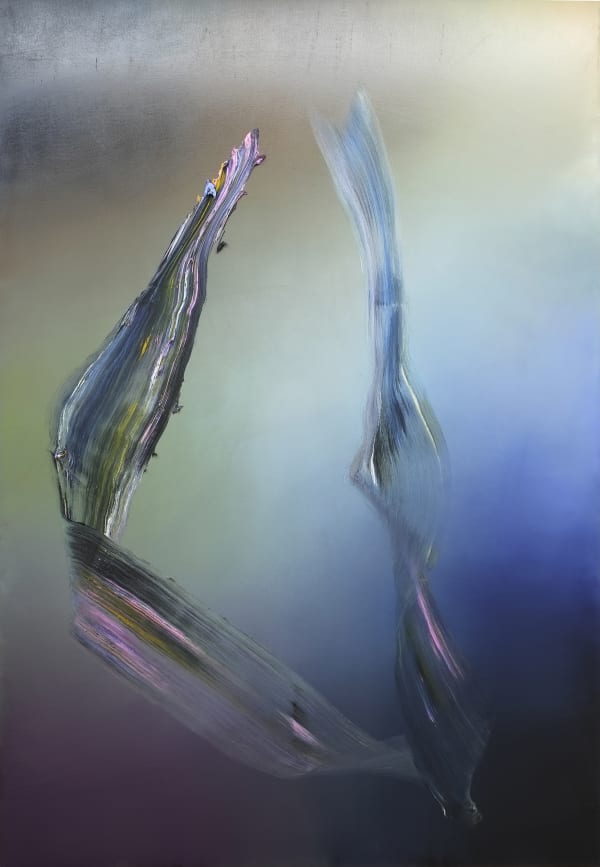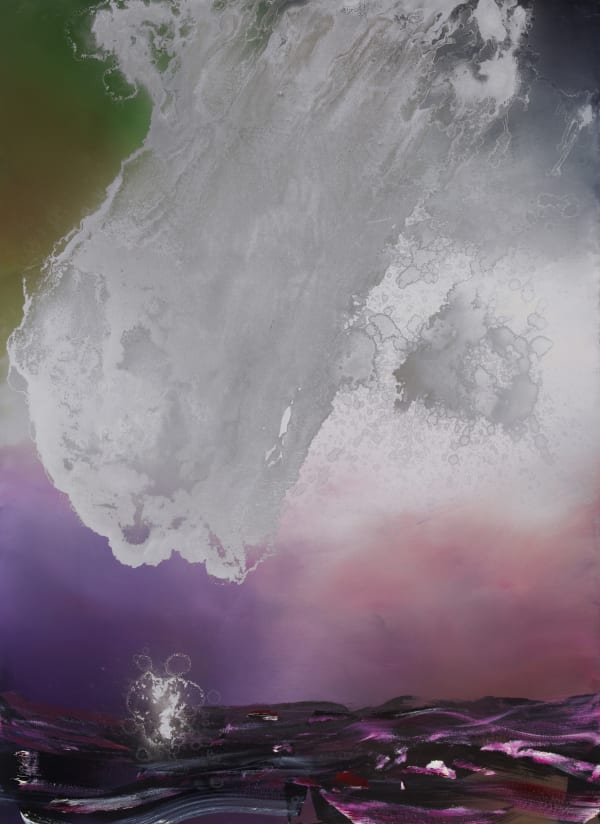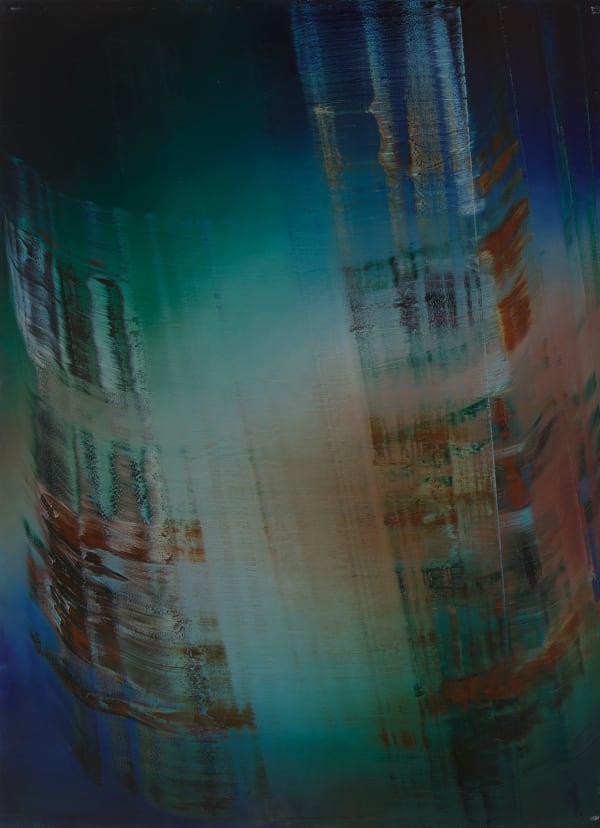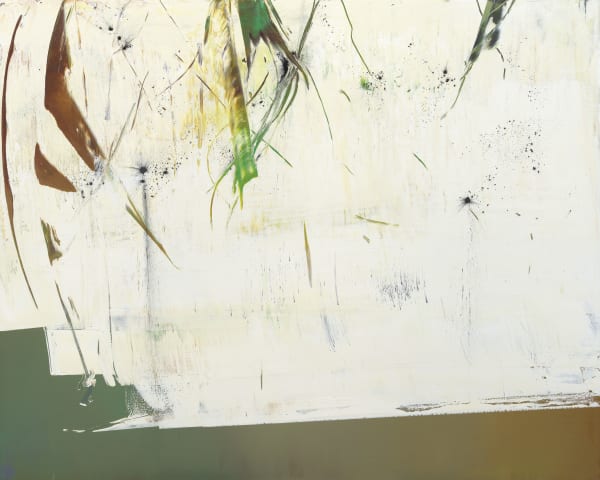"The good artist is an ally of chance."
Hubert Scheibl, whose artistic cosmos always revolves around evolution, the origin of the world, nature and its forms, welcomes the coincidence that takes place during painting: With sole effort and intention, this kind of painting would not succeed.
In contrast to his scratched paintings, which allow a glimpse under the layers and thus reveal them, the works with silver spray conceal the image; and yet this concealment encourages one to suspect what is underneath and to let one's own interpretation play.
The time of creation of his painting is determined by the material, for the surface, the oil paint, must be soft in order to form it, it is alive and can only be controlled by this. The advancing drying process dictates the timing, a welcome time pressure that does not allow the artist to rest. Some paintings are often reworked when the bottom layer is completely dry. Be it that the loop in the series Ones is placed on the picture's square, be it that in the latest series End of Flags a wide squeegee lays the paint over the canvas like a delicate curtain, or in the fact that Scheibl covers his pictures with silver emulsion to a certain extent.
But it is also the present that Hubert Scheibl lets speak in his works. The so-called Cage Paintings were also created during the Corona period, which was demanding for everyone. Rather kept in muted colours, the oscillating layers of colour are broken up by vertical incisions. Cage - cage - thus also immediately reveals the reference to bars. There is also the personal aspect in this series: Corona has made travelling, as Scheibl loves and knows it, almost impossible, it has locked him up, put him behind bars.
Hubert Scheibl lives and works in Vienna
born 1952 in Gmunden, Upper Austria
Studied at the Academy of Fine Arts in Vienna from 1976 to 1981 under Max Weiler and Arnulf Rainer. In the 1980s he was a member of the Neue Wilden group. He is one of the most important Austrian representatives of abstract painting.
International exhibitions such as the Bienal de São Paulo in 1985 or the Biennale di Venezia in 1988, made him known to a wide audience.
His works from collections or on loan are also often shown in museums, for example in 2023 at the Lower Belvedere in Vienna or at the Kunsthaus Zurich, and in 2021 in a solo exhibition at the Albertina in Vienna.
HUBERT SCHEIBL. PAINTERLY TRACES IN SPACE
Trace and space combine in Hubert Scheibl's pictorial world in a complex and manifold way. In his artistic beginnings in the 1980s, Scheibl was one of the leading proponents of neo-expressionist painting based on personal handwriting. Traces of the self floated on the picture surface, whether through explosive discharges of the brush or by means of expansive notations with the pen; a physical inscription.
In the recent series of paintings Ones, Scheibl condenses the gesture into a sign-like looping structure that floats in the spherical pictorial space. Index and icon combine with each other. The abstract gesture becomes a figure, a painterly object. In Abstract Expressionism, Franz Kline, for example, and also the Austrian informal painter Markus Prachensky force the gesture as a direct setting on the picture ground: Kline's black bar-like constructions on a white ground as well as Prachensky's Rouge sur noir pictures. Similar to a flash of lightning, the gestural settings illuminate the picture surface as a sublime powerful abstract figure with which we are directly confronted. Scheibl's Ones looping formations are more like jellyfish-like organisms, floating gently and elegantly in the watery atmospheric pictorial space. Even though the artist does not intend to make any explicit reference to nature in the sense of depicting reality, it is always present. Scheibl rejects any purist-dogmatic attitude of abstract art. We are nature and part of evolution. The artist shows this on a large as well as a small scale - galactic stellar spaces, deep-sea zones in twilight, microcosmic structures, ultrasound images and virological cellularity. Scheibl contrasts the guided gestural brushstroke with the pouring of paint, which is more oriented towards chance, as especially in the Nicotine on Silverscreen series. The shimmering silver paint partially seals the underlying spherical-colouristic pictorial spaces, like dense clouds with whirlwind inclusions, which astronauts as well as we perceive via satellite images looking down on our earth. Scheibl's painting is a powerful processual cosmos, a Milky Way of images. In part, his groups of pictures and blocks of works are clearly distinguishable from one another, and have different stylistic-formal qualities: Graphic - painterly, spherical grounds - agitated expressionist pictorial zones, poured colour varnishes - gestural brushstroke formations. Often these elements intertwine in one and the same picture. Brittle rugged hybrids emerge, transitional works that lead to other pictorial creations. In the white-dominated paintings, graphic and painterly means mix, the two-dimensional and the spatial, when the artist covers a spherical coloured picture surface with white paint and then subsequently wounds it with graphic strokes and strokes. From the wounds of the white skin gapes the colouristic splendour of the painterly flesh.
Due to the pandemic situation, Scheibl's travelling was extremely restricted. Enclosure is the theme of the new Cage paintings. They are mostly dark and gloomy, with vertical line structures suggesting cage-like forms. Scheibl refers here to Francis Bacon's existentialist obscure portrait paintings of the Velazquez popes, whose cries are swallowed up by the powerful darkness of the painting.
Scheibl needs pure drawing, or gouache on paper, as a counterbalance to the psychophysically immensely demanding acts of painting. Fine nerve networks, informal signs and microscopic structures interweave on the sheet.
(Florian Steininger)
-

SPEKTRUM FL
Gruppenausstellung 31 Aug - 2 Nov 2024 bechter kastowsky gallery. SchaanThe bechter kastowsky gallery is showing a selective choice of works by its artists at its location in Schaan. The exhibition “SPEKTRUM FL” creates a link between past and future...Read more -

Welcome 2024
27 Jan - 24 Feb 2024 bechter kastowsky gallery. Schaan27 January till 24 Fabruary 2024Read more -

Welcome 2023
group exhibition 21 Jan - 4 Mar 2023 bechter kastowsky gallery. Schaanwe start the year with a great selection of works by our artistsRead more -

10 years bechter kastowsky gallery!
Mario Dilitz / Jakob Gasteiger / Aurelia Gratzer / Karen Holländer / Petar Mirkovic / Klaus Mosettig / Ahmet Oran / Drago Persic / Hanna Roeckle / Hubert Scheibl / Christoph Schirmer / Martin Schnur / Anneliese Schrenk / Liliane Tomasko 10 Sep - 29 Oct 2022 bechter kastowsky gallery. ViennaRead more -

Summer 2022
Karen Holländer. Liliane Tomasko. Hubert Scheibl. Jakob Gasteiger 13 Jul - 13 Aug 2022 bechter kastowsky gallery. SchaanRead more -

Hubert Scheibl
End of Flags 12 May - 2 Jul 2022 bechter kastowsky gallery. SchaanRead more
-

Museum Angerlehner. Collector`s Choice. Angerlehner. Löw-Radeschnig
with works by Constantin Luser, Hermann Nitsch, Hubert Scheibl, Martin Schnur and others 9 Nov 2024 - 30 Mar 2025With ‘Collector's Choice | Angerlehner x Löw-Radeschnig’, the Museum Angerlehner presents a unique selection of artworks from the renowned private art collections of Heinz J....Read more -
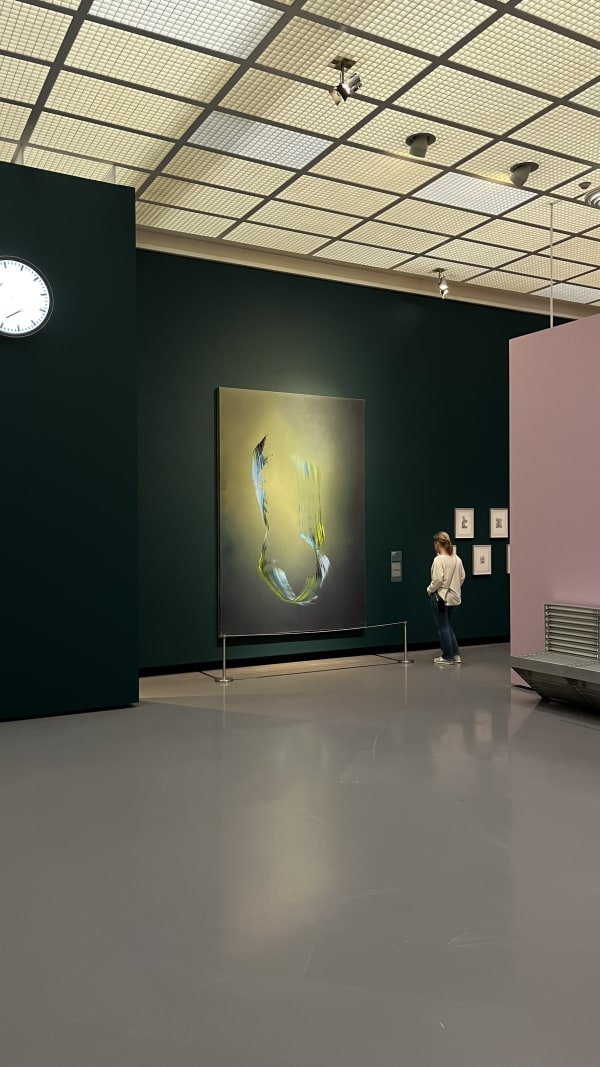
Kunsthaus Zürich. Time
From Dürer to Bonvicini 22 Sep 2023 - 14 Jan 202421, 22... Inexorably it advances, just as you are reading this text: time. Join us on an inspiring journey through time, which takes as its...Read more -
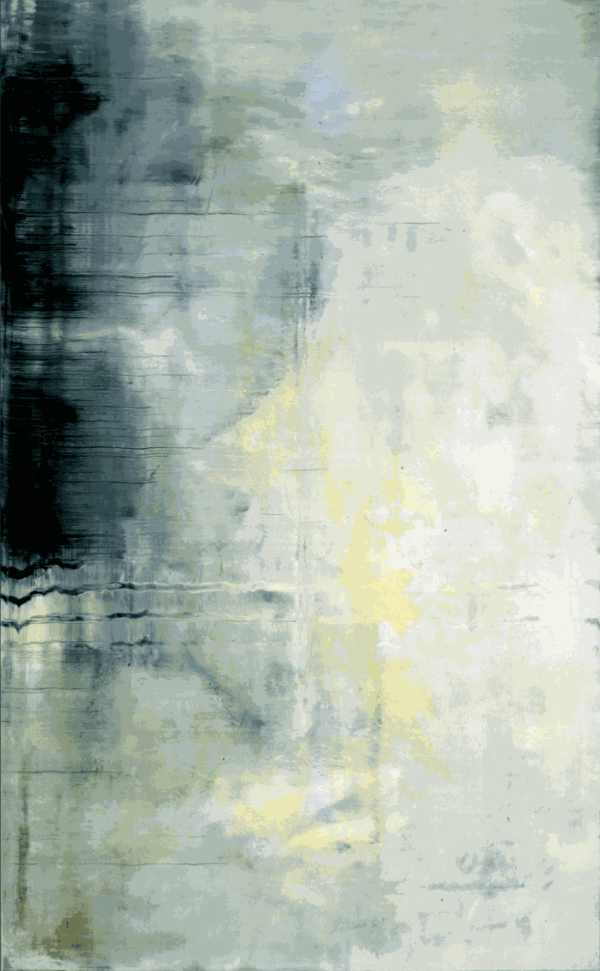
Colossal. Painting On A Grand Scale. Lower Belvedere. Vienna
with works by Hubert Scheibl, Hermann Nitsch, Jakob Gasteiger, Herbert Brandl and others 22 Jun - 27 Aug 2023It requires confidence, skill, imagination, and courage for an artist to tackle a huge canvas. The results are mostly major works of art: impressive, spectacular...Read more -
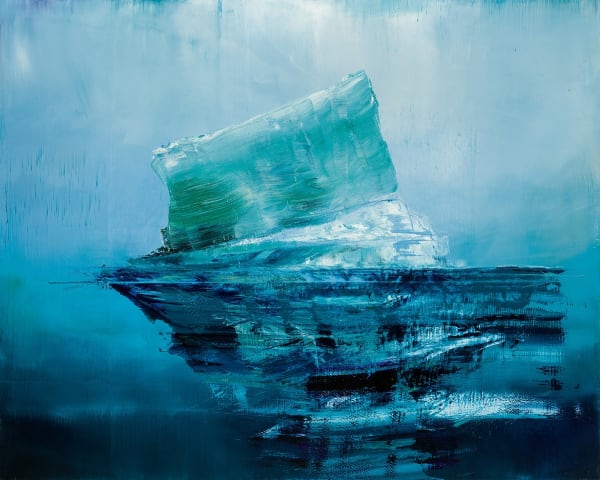
Hubert Scheibl. Seeds of Time
Albertina Vienna 31 Aug - 5 Dec 2021Under the title Seeds of Time, the ALBERTINA is showing a selection of recent works by Hubert Scheibl , most of which were created in...Read more
-

STAGE BREGENZ 2024
Contemporary Fair / Art / Design 22 - 25 Feb 2024STAGE Bregenz is a meeting place for a broad art and culture audience and at the same time a stage for the diverse interactions of...Read more -

LIHGA 2022
Mario Dilitz. Karen Holländer. Hubert Scheibl. Martin Schnur 16 - 24 Sep 2022For the first time we are taking part in the LIHGA. Not an art fair, but a fair for Liechtenstein and the neighbouring regions.Read more -
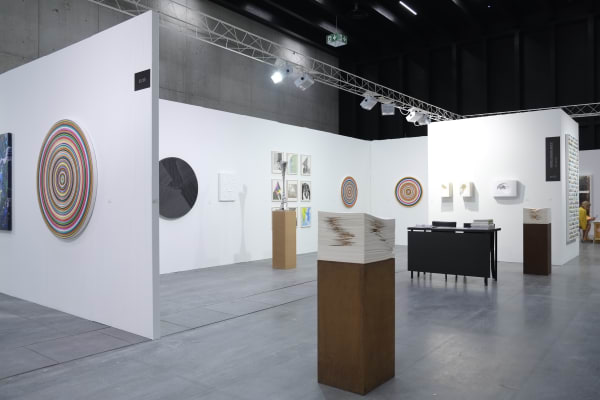
ART BODENSEE 2017
Gasteiger. Glajcar. Patkowitsch. Peters. Scheibl. Willing. Yalcindag 21 - 23 Jul 2017Gasteiger. Glajcar. Patkowitsch. Peters. Scheibl. Willing. YalcindagRead more


